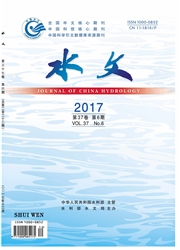

 中文摘要:
中文摘要:
水资源生态足迹模型为水资源可持续利用的综合评价提供了新方向.首先分析了河南省2005~ 2014年间的水资源生态足迹和生态承载力的动态变化,然后利用指数分解法中的LMDI模型对水资源 生态足迹的影响因素进行了深入研究.结果表明:(1)2005~2014年间河南省水资源生态足迹总体稳中 有升,贡献大小依次为农业用水〉工业用水〉生活用水跃生态环境补水;(2)万元GDP水资源生态足迹逐 年下降,水资源利用效率不断提高,但10年间均出现不同程度的水资源生态赤字,水资源利用前景不容 乐观;(3)4种分解因素对水资源生态足迹增长的推动作用大小排序为:结构效应跃经济效应跃人口效应跃 技术效应,但经济效应有逐渐赶超结构效应的趋势.
 英文摘要:
英文摘要:
Water resources ecological footprint model offers a new method for evaluating the sustainable utilization of water resources. This study firstly analyzed the water resources ecological footprint and the ecological carrying capacity of water resources in the years from 2005 to 2014. And then used LMDI method to analyze that impact the water resources ecological footprint. The result show that The total water resources ecological footprint increased and the contribution size could be ranked as agricultural water〉industrial water〉domestic water〉ecological water during 2005-2014. The water resources ecological footprint of ten thousand Yuan GDP is decreased year by year,which indicates that the water resources efficiency is increasing. But there is different levels of ecological deficit in the past 10 years, the water resources utilization prospect is still not optimistic. The contribution order of four index factorizes for water ecological footprint is as follows: water footprint structure effect 〉economic effect 〉population effect 〉 technical effect,and the economic effect has a tendency to catch up the structure effect.
 同期刊论文项目
同期刊论文项目
 同项目期刊论文
同项目期刊论文
 期刊信息
期刊信息
